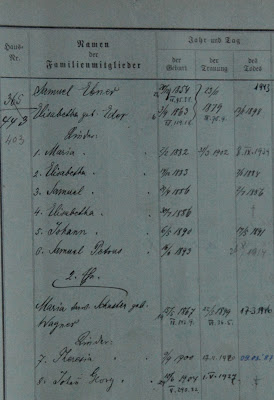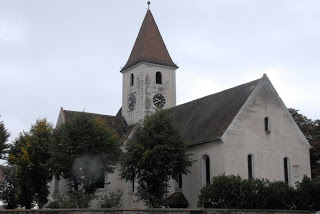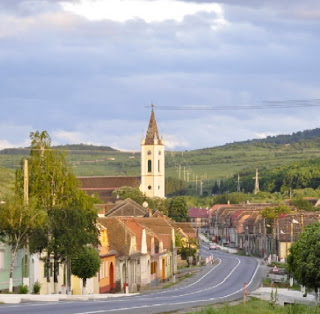It’s time for another Carnival of Genealogy Post – (CoG) where members of the genealogy blogging community share ancestor stories around a common theme. For September we’re writing about “Our Ancestor’s Place of Worship.” (The promised post on Josef Gärtz’s new job will show up in three weeks—on September 20th).
Churches in my family’s past were centers of faith and community, but for me they have been sources of revelations. Not the kind found in the last book of the Bible, but rather as repositories of family secrets that have only recently come to light.
Before they came to America, my grandparents each attended an Evangelical Lutheran Church in their respective home towns in Siebenbürgen—the area we call Transylvania.
Their ties to these churches was represented in the identical hymnals they each thought important enough to bring with them to America. The title on both was “Gesangbuch” literally, “song book”), and the title pages were stamped with the following: “Evangelical Land Church in the Siebenbürgen Section of Hungary,” indicating the area in which both churches resided.
These churches contained a wealth of family history, but my brothers and I had no clue as to these treasures until our 2007 roots-finding trip to Romania.
My grandmother’s church in Grosspold held a Familien Buch—Family Book, in which we learned of her parents’ marriage, and the losses my grandmother suffered of her siblings and her mother, and the subsequent remarriage of her father, Samuel. (See: Life and Death Abbreviated).
Even Lisi’s grandmother Maria’s 1859 marriage to Johann Eder and their children ‘s lives (see right) had been recorded in that book.
My grandfather, Josef’s, church in nearby Neppendorf, was a trove of surprises. Tucked into the back of this church was a small museum of ethnic German life. There my brothers and I discovered three family photographs, identical to ones we had in our own collection, gracing its walls! (See Spilling Secrets).

At the top: Johann and Maria Eder were my grandmother, Lisi’s, grandparents. #2 Elisabetha, died at age 34 from pneumonia. She was the mother of my grandmother, Lisi, who was 10 at her death. See Life and Death Abbreviated.
A former pastor at the Neppendorf Lutheran Church had researched and created genealogies for many of the members, including the Gärtz family. For the first time, I learned that Josef Gärtz’s ancestors had originally come to Siebenbürgen/Transylvania from a town called Gerstheim in the lower Rhine (Niederrhein) region of Alsace, at that time, as now, a part of France. Gerstheim, like so many towns in this oft-fought-over border area between France and Germany, was populated by Germans. We had known none of this. Could we have faith in the pastor’s research?
The Neppendorf church’s genealogy document read, regarding Michael Gerz who was the first ancestor listed:
All people living in Neppendorf with the family name “Gerz” [an alternative spelling for Gärtz] originated from this Michael Gerz who came from Gerstheim.”
That left us with the impression that this “Michael Gerz” which the document noted was born in “1771,” came as an adult to Gerstheim. Yet another Evangelical Lutheran Church, this time in Gerstheim—came to prove several pieces of the Neppendorf-recorded genealogy, to be wrong!
In the next few weeks, we’ll go back in time, to the 18th Century, to find out what the Gerstheim church records had to say about which of Josef Gärtz’s ancestors made the 1,000 mile trek from France to Siebenbürgen, then in Hungary, and why “it takes a village” to find an ancestor.
We’ll check back in a few weeks with Josef Gärtz and his new job in a Chicago Saloon, which gave him and Lisi the foundation for their future. But first—another immigrant family—Josef’s great-great-grandfather, who traveled the prodigious distance from Alsace to Siebenbürgen, and how I teased out the facts with help from my “village.”
Friends: I won’t have access to my computer for the next two posts, so I hope you’ll check in, as usual, on Tuesdays, to see how I unravelled many contradictions I found in the Neppendorf Church records.


Very interesting!
Thanks for dropping by, Ellen!
If one Church’s records differ from another’s, which is correct?
Follow along the next two weeks and you’ll find out. But bottom line, if one is the primary document and the other created a summary based on info researched — the primary document holds sway — as it was recorded at the time of the event. Even those folks could make mistakes (e.g., my grandmother’s birth year was recorded one year off), but like Monks copying manuscripts, the further you get away from the original, the more opportunity for error. Thanks for asking!
Churches are a great place to look for info…cemetaries too:)
As usual, I eagerly follow your grandfather’s story installment by installment. How wonderful you had help from the churches. Recently, I was told by the church that holds many many of my ancestors records, “We don’t do genealogy”.
Hey Margel,
I’m taking a little detour into the distant past with these next few posts, spurred by the CoG “Places of Worship” prompt. It offered a perfect segue into some discoveries I wanted to write about, all related to discoveries in churches. “We don’t DO genealogy???” They can’t even let you “have at” those documents? Seems to me you could pursue it legally — but who has the time and money?
Very interesting. I have ancestors who allegedly did the opposite — migrated from what was then called Bohemia (now Czechoslovakia) to Weyersheim in Alsace (Bas-Rhin) in the mid-1600s. If the stories are true, my Huss ancestors were followers of Jan Hus who repopulated Weyersheim after the devastation of the Thirty Years war. Who knew there was so much migration over such large distances!